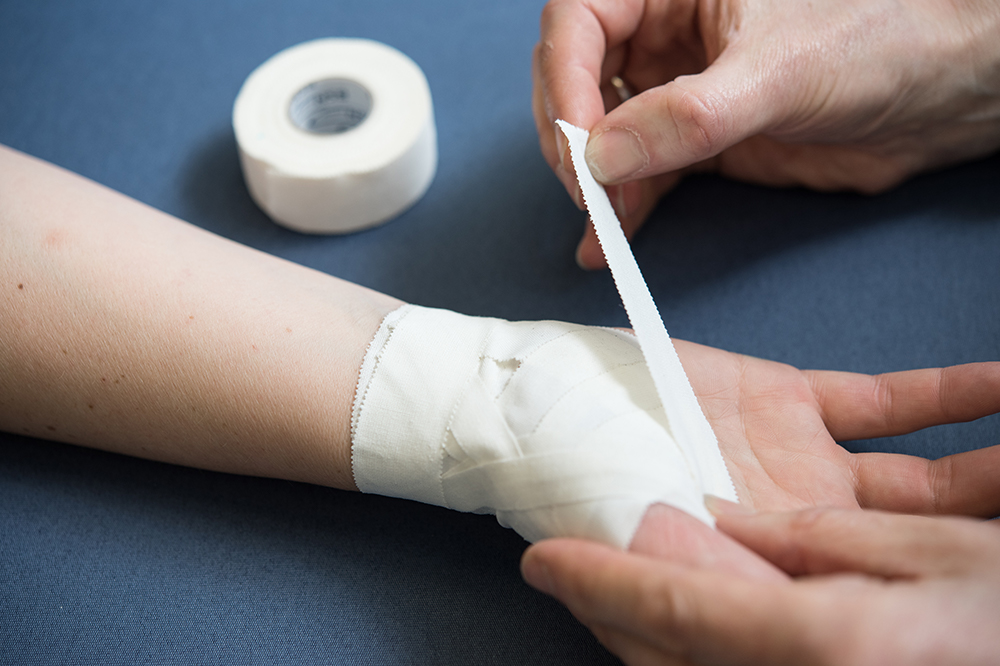Sue Watson Postgraduate Presentation Prize

Sue Watson Postgraduate Presentation Prize
We are delighted to announce that student members from the Pain Centre Versus Arthritis are among the winners of the 2021 Sue Watson Postgraduate Presentation Prize. Congratulations to Onosi and Abas for their awards.
Second Prize Winner
Abasiama Obotiba, Pain Centre Versus Arthritis, School of Medicine.
Imaging features associate with symptoms and structural changes of hand osteoarthritis: a multi-method approach.
Supervisors: Abhishek Abhishek, Weiya Zhang, Michael Doherty
Symptomatic hand osteoarthritis (OA) is common amongst community-dwelling adults. Symptoms include hand pain, function impairment and stiffness, which impact on quality of life. However, determinants of symptoms and progression of joint damage remain unclear. Imaging is central to improving our understanding of these. Therefore, this study aimed to systematically review in observational studies the association between imaging [ultrasound and magnetic resonance imaging (MRI)] features and symptoms, and progression of joint damage in hand OA, and to re-examine this in a community-derived cohort with nodal hand OA using ultrasound.
From our systematic review and meta-analysis, all ultrasound/MRI features were associated with joint tenderness, and ultrasound-detected synovitis was associated with pain. Findings also demonstrated association between ultrasound/MRI-detected synovitis and progression of joint damage. Similar findings were observed between MRI-detected bone marrow lesion and progression of joint damage.
From our observational study, all ultrasound-detected changes were associated with joint tenderness, whilst ultrasound-detected synovitis was associated with hand pain, function impairment, and stiffness, and this relationship was independent of gender, BMI, age and pain catastrophising scale. These findings suggest the involvement of inflammation and subchondral bony change in symptoms and progression of joint damage in hand OA. Hence, ultrasound and MRI may be useful in identifying joints at adverse risk of severe structural damage.
Third Prize Winner
Onosi Ifesemen, Pain Centre Versus Arthritis, School of Medicine.
Fatigue, a prevalent and persistent problem – Data from the Knee Pain in the Community Survey.
Supervisors: David A Walsh, Daniel F. McWilliams
Fatigue is a ubiquitous symptom in musculoskeletal diseases. It is associated with poorer quality of life (QoL). Often dismissed as a benign symptom in clinical practice, the exact cause of fatigue is uncertain. Several mechanisms including organic, psychosocial, and environmental have been proposed and bisect different disease conditions. It is unclear if fatigue results from an individual’s response to disease, or an inherent trait. Investigating fatigue in the general population would provide insight to mechanisms of fatigue irrespective of disease. This study aims to explore fatigue in the general population.
Objectives
Describe characteristics associated with concurrent fatigue
Describe baseline characteristics associated with incident fatigue
Methods
Data from the knee pain in the community (KPIC) cohort were analysed. KPIC is a community-based cohort study of people ≥40yrs residing in the East Midlands. Fatigue was measured with a binary (yes/no) self-report question, and the SF12 Vitality subscale. Incident fatigue was defined as fatigue absent at baseline but present in year 1. Covariates investigated included pain, sleep, mental health, comorbidity, body mass index and demographics. Univariate and multivariable regression analyses were conducted. Risk ratios (RR) and standardised regression coefficients were estimated. Model performance and relative importance of covariates were assessed using areas under receiver operating characteristic (AUROC) curves and dominance analyses, respectively.
Results
8767 participants were included at baseline, mean age 62 years and 57% female. Mean vitality score was 43.39 (±12), and 63% reported fatigue. 1.4% reported a diagnosis of chronic fatigue syndrome. Female sex (RR; 1.07, CI:1.01 to 1.13), depression (RR; 1.02, CI:1.01 to 1.03), anxiety (RR; 1.01, CI:1.00 to1.02), higher comorbidity count (RR; 1.05, CI:1.02 to 1.07), poor sleep (RR; 0.93, CI:0.92 to 0.94) and worse pain (RR; 0.95, CI:0.91 to 0.97) were together associated with concurrent fatigue at baseline (AUROC; 0.85, CI:0.84 to 0.86). Sleep was the most important factor, and sex, the least important. Analysis with SF12 vitality produced similar results (R2=0.47). Incident fatigue was predicted by baseline pain (RR; 0.82, CI: 0.73 to 0.92), anxiety (RR; 1.06, CI:1.03 to 1.09) and sleep (RR; 0.94, CI: 0.91 to 0.98). AUROC; 0.67(CI:0.64 to 0.70).
Discussion / Conclusions
Fatigue is a prevalent symptom in the general population. Sleep, mental health, and pain each plays a role in the development of fatigue. More studies are required to evaluate the causal mechanisms of fatigue.
Relevance to patients/public, other scientists:
Understanding the multiple mechanisms of fatigue, which is not only dependent on sleep quality, will open opportunities to developing more effective treatments. Fatigue is an important, patient-centred outcome that might improve with effective pain or mood management, as well as a core outcome for sleep interventions.
The Sue Watson presentation was held on the 17th of March 2021.
About Sue Watson
Professor Sue Watson studied and worked at the University for almost 30 years as PhD student, research fellow, senior lecturer, reader and, from 2002, professor of pre-clinical oncology. The Sue Watson Postgraduate Presentation Prize is given out after an oral presentation which postgraduate research students do between the 18 to 24 month stage of their studies. The presentation is made to an audience of fellow research students, supervisors and other researchers from the school. The presentations are marked by a panel of judges and cash prizes are awarded for the best presentations. They are also an opportunity for students to organise their data into a form which can be presented to their peers under formal conditions.